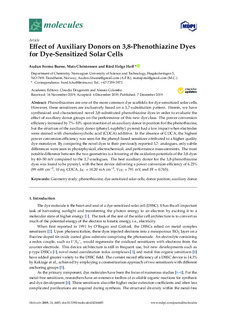Effect of Auxiliary Donors on 3,8-Phenothiazine Dyes for Dye-Sensitized Solar Cells
| dc.contributor.author | Buene, Audun Formo | |
| dc.contributor.author | Christensen, Mats | |
| dc.contributor.author | Hoff, Bård Helge | |
| dc.date.accessioned | 2019-12-11T10:22:32Z | |
| dc.date.available | 2019-12-11T10:22:32Z | |
| dc.date.created | 2019-12-10T13:25:19Z | |
| dc.date.issued | 2019 | |
| dc.identifier.citation | Molecules. 2019, 24 (24), 4485-4494. | nb_NO |
| dc.identifier.issn | 1420-3049 | |
| dc.identifier.uri | http://hdl.handle.net/11250/2632703 | |
| dc.description.abstract | Phenothiazines are one of the more common dye scaffolds for dye-sensitized solar cells. However, these sensitizers are exclusively based on a 3,7-substitution pattern. Herein, we have synthesized and characterized novel 3,8-substituted phenothiazine dyes in order to evaluate the effect of auxiliary donor groups on the performance of this new dye class. The power conversion efficiency increased by 7%–10% upon insertion of an auxiliary donor in position 8 of the phenothiazine, but the structure of the auxiliary donor (phenyl, naphthyl, pyrene) had a low impact when electrodes were stained with chenodeoxycholic acid (CDCA) additive. In the absence of CDCA, the highest power conversion efficiency was seen for the phenyl-based sensitizer attributed to a higher quality dye-monolayer. By comparing the novel dyes to their previously reported 3,7- analogues, only subtle differences were seen in photophysical, electrochemical, and performance measurements. The most notable difference between the two geometries is a lowering of the oxidation potentials of the 3,8-dyes by 40–50 mV compared to the 3,7-analogues. The best auxiliary donor for the 3,8-phenothiazine dyes was found to be pyrenyl, with the best device delivering a power conversion efficiency of 6.23% (99 mW cm−2, 10 eq. CDCA, JSC = 10.20 mA cm−2, VOC = 791 mV, and FF = 0.765). | nb_NO |
| dc.language.iso | eng | nb_NO |
| dc.publisher | MDPI | nb_NO |
| dc.rights | Navngivelse 4.0 Internasjonal | * |
| dc.rights.uri | http://creativecommons.org/licenses/by/4.0/deed.no | * |
| dc.title | Effect of Auxiliary Donors on 3,8-Phenothiazine Dyes for Dye-Sensitized Solar Cells | nb_NO |
| dc.type | Journal article | nb_NO |
| dc.type | Peer reviewed | nb_NO |
| dc.description.version | publishedVersion | nb_NO |
| dc.source.pagenumber | 4485-4494 | nb_NO |
| dc.source.volume | 24 | nb_NO |
| dc.source.journal | Molecules | nb_NO |
| dc.source.issue | 24 | nb_NO |
| dc.identifier.doi | 10.3390/molecules24244485 | |
| dc.identifier.cristin | 1758861 | |
| dc.description.localcode | © 2019 by the authors. Licensee MDPI, Basel, Switzerland. This article is an open access article distributed under the terms and conditions of the Creative Commons Attribution (CC BY) license (http://creativecommons.org/licenses/by/4.0/). | nb_NO |
| cristin.unitcode | 194,66,25,0 | |
| cristin.unitcode | 194,14,0,0 | |
| cristin.unitname | Institutt for kjemi | |
| cristin.unitname | Prorektor for utdanning | |
| cristin.ispublished | true | |
| cristin.fulltext | original | |
| cristin.qualitycode | 1 |
Files in this item
This item appears in the following Collection(s)
-
Institutt for kjemi [1359]
-
Publikasjoner fra CRIStin - NTNU [37325]

